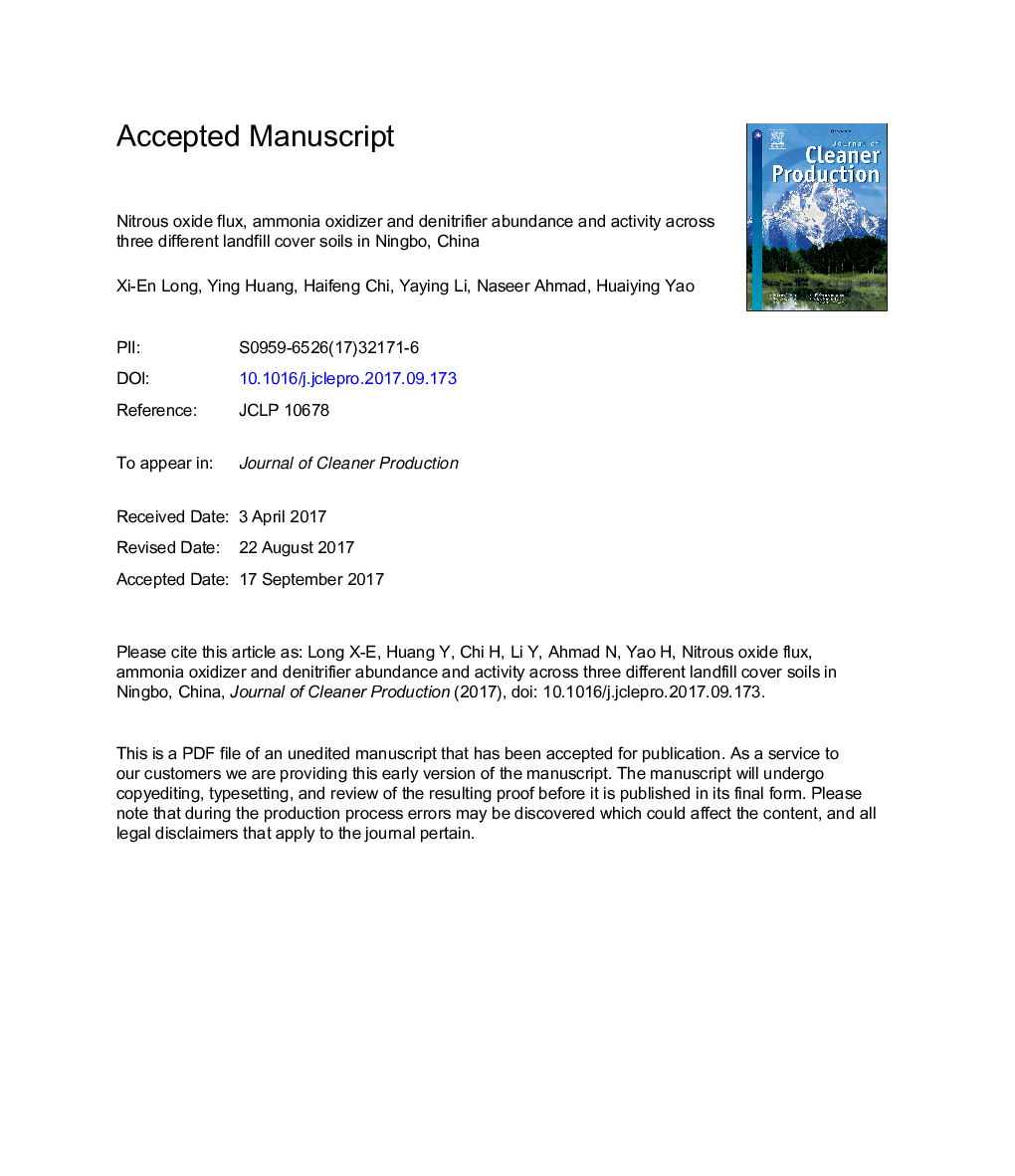| کد مقاله | کد نشریه | سال انتشار | مقاله انگلیسی | نسخه تمام متن |
|---|---|---|---|---|
| 5479217 | 1522084 | 2018 | 36 صفحه PDF | دانلود رایگان |
عنوان انگلیسی مقاله ISI
Nitrous oxide flux, ammonia oxidizer and denitrifier abundance and activity across three different landfill cover soils in Ningbo, China
ترجمه فارسی عنوان
شار اکسید نیتروژن، اکسید کننده آمونیاک و فراوانی ضایعات و فعالیت در بین سه دفع زباله های مختلف در خاک نینگبو، چین
دانلود مقاله + سفارش ترجمه
دانلود مقاله ISI انگلیسی
رایگان برای ایرانیان
کلمات کلیدی
موضوعات مرتبط
مهندسی و علوم پایه
مهندسی انرژی
انرژی های تجدید پذیر، توسعه پایدار و محیط زیست
چکیده انگلیسی
Nitrous oxide (N2O) is an important greenhouse gas, whose production from landfill sites has not been given adequate attention yet. Municipal solid waste disposal site could be a potential contributor to N2O emissions. Here, we conducted a transect study to determine N2O flux and the abundance and activity of nitrifiers and denitrifiers across three different landfill sites (Ninghai: NH, Xiangshan: XS, and Fenghua: FH). Microbial abundance and community structure were determined using quantitative polymerase chain reaction, terminal-restriction fragment length polymorphism (T-RFLP), and clone library. The highest mean N2O flux (3.44 mg mâ2 hâ1) and global warming potential (1025.12 eq-CO2 mâ2 hâ1) were detected at the XS and NH sites, respectively. Soil nutrients (dissolved organic C, dissolved organic N, and total organic C), C:N ratio, and the abundance and activity of nitrifiers and denitrifiers determined the flux of N2O across the three landfill cover soils. Nitrification and denitrification made comparable contribution to N2O production in the soils. Nitrososphaera-associated archaeal amoA gene accounted for 99% of ammonia-oxidizing archaea (AOA) sequences at the XS site, whereas soil/sediment cluster I of AOA dominated (>50%) at the NH and FH sites. The predominant ammonia-oxidizing bacteria sequences (>75%) of the FH site were affiliated with the Nitrosomonas lineage and more than half the sequences belonged to cluster 3b at the XS and NH sites. The nirK sequences affiliated with Alpha-proteobacteria (Phyllobacteriaceae, Rhizobiaceae and Bradyrhizobiaceae) (>78%) and nirS sequences affiliated with Beta-proteobacteria (>45%) governed the denitrifiers in the soils. Heavy metals (Cu and Cr), C:N ratio, and C sources (total C and dissolved organic C) determined the distribution of the nitrifier and denitrifier communities. In conclusion, the condition of the landfill sites contributed significantly to the N2O emissions, and AOA and nirK-type denitrifiers dominated the leachate-affected cover soils.
ناشر
Database: Elsevier - ScienceDirect (ساینس دایرکت)
Journal: Journal of Cleaner Production - Volume 170, 1 January 2018, Pages 288-297
Journal: Journal of Cleaner Production - Volume 170, 1 January 2018, Pages 288-297
نویسندگان
Xi-En Long, Ying Huang, Haifeng Chi, Yaying Li, Naseer Ahmad, Huaiying Yao,
